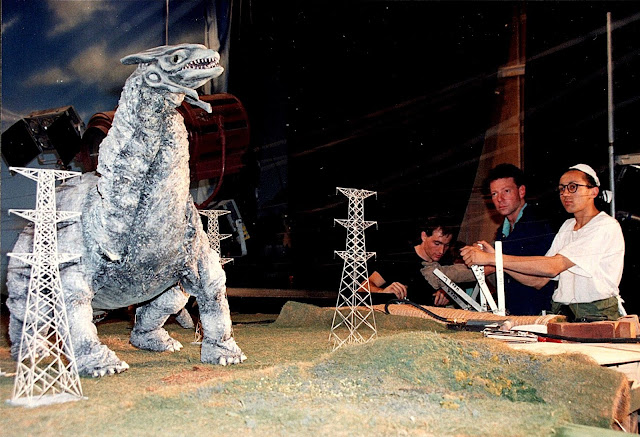The
Ultraman production purchased a collection of miniature buildings that
were originally made for an unfinished version of Total Recall being
made in Australia in 1987. The original miniatures supervisor for the 1987 Total Recall was Gene Rizzardi.
The miniatures had been stored in a shipping container outside in a paddock in Western Sydney for about two years. When we opened the shipping container we were hit with a wall of toxic fumes. We decided to wait with the doors fully open for about half an hour to get some fresh air to circulate before venturing inside to inspect the contents. The summer heat and winter cold had resulted in a expansion and contraction of all the glued joints of the model buildings and almost all of them were literally coming apart at the seams. They were chiefly made of acrylic (perspex) sheet that was just cemented together with very little structural reinforcement.
I
gather when they were originally built they were made to be placed in a
specific position in a miniature street set and not be moved again
until they were finished shooting. The requirements for the Ultraman
production would be that they were constantly shuffled around for
different shots and stacked on top of each other to make different
configurations. This meant that some sturdy timber reinforcement was
required.
One of my tasks on Ultraman was to reassemble, repair and re-inforce all the buildings which occupied me for a some weeks.
The
original miniatures were all made to depict a specific street in New York,
namely Park Avenue. Here I am working on what used to be known as the Pan Am
building which was to be positioned right at the far end of the street.
You
can see the side of this building had started to come off and I am
attempting to re-glue it. The rest of the model considering all the
small details survived surprisingly intact.
The picture below shows one
of the buildings being used for a shattering window effect. Assistant
director Jamie Crooks (left), Adam Grace (rear), Camera assistant Joanne
Parker and D.O.P. Steve Newman setting up the shot.
The camera on
the left of frame was an Arri SR a 16mm camera capable of 250 frames per
second, a real workhorse and totally reliable. Jo the Camera assistant
is hunched over the other 16mm camera we used, a Photosonics
actionmaster capable of 500 frames per second. Unfortunately not so
reliable and prone to jamming, but miniature explosions at 500 fps are
gorgeous.
A tiny air cannon was placed behind the window which blew out a thin piece of breakaway glass with extra debris piled up inside.
Here I am modifying one of the buildings for the first test of the breakaway glass and pyro explosion effect. Pre-damaged floors were added in and the facade was cut away to be replaced with breakaway glass and pre-painted strips to match the existing window frames.
They had also built vehicles that used Tamiya Tamtech 1/24 scale radio controlled chassis that could drive down the street. I purchased one of them when the production had a big firesale upon winding up. I also got some other RC vehicles which were based on a modified Thunder Tiger Silver Fox chassis with Marui Big Bear Tyres on custom CNC aluminium wheels. I also picked up a Tamiya 1/16 scale RC Leopard tank chassis.
Unfortunately I dont have any of this haul any more except for a NorthWest Short Line Chopper, a tool I still use for cutting up Evergreen styrene strips.




















































